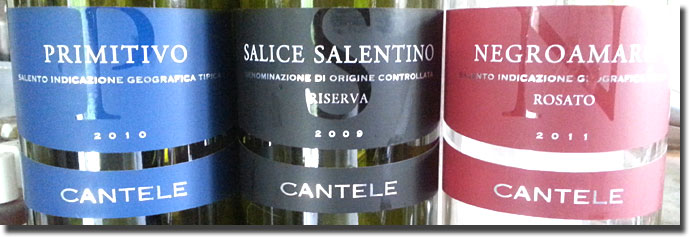Three from Cantele
We have always been very transparent regarding the fact that we have no qualms about receiving wine samples for review. We have always been honest with posting our impressions of samples sent to us, and we don’t always give good reviews. There have been rare occasions in which we chose not to review samples, because we could find nothing good to say about them, and felt it was better simply to say nothing at all. Usually, however, we can find good attributes in just about anything we review; sometimes, our only reservations are that certain things just aren’t made in styles that we favor. Such was the case with two of the three wines we tried from Cantele this summer.
I had seen Cantele wines locally over the past few years, but until we received review samples, had never tasted them, or indeed, knew little about the producer, other than it was an Italian operation. Visiting their website, I discovered that the Cantele family entered the wine trade after World War II, built their own winery in 1979, functioning primarily as a bottler of purchased wines until the 1990s, when they began to acquire vineyards to produce their own wines. A more detailed account can be found here, and it’s an interesting read. Today, the Cantele winery produces 2 million bottles annually, including not only indigenous Pugliese grapes like Primitivo and Negroamaro , but also international varieties like Chardonnay, Merlot and Syrah.
We started off our survey with the Salice Salentino Reserva, to see how it compared to some old friends of ours. U.S. price ranges listed are from winesearcher.com. Production data is quoted directly from the Cantele web site.
2009 Cantele Salice Salentino Reserva D.O.C., 100% Negroamaro, 13% alc., $8.20-10.99: We’re mostly acquainted with the wines of Salice Salentino through Taurino‘s bottlings from the ’80s and ’90s, and this bears little resemblance to that funky old school style that we so enjoyed. Dark garnet in color, and fairly fruit forward, with earthy black cherry and plum flavors and aromas; full bodied with good structure and length. There’s technically nothing wrong with this, but it’s too ripe, too “modern,” too “international” for our taste. “After being destemmed and crushed, the must macerates with skin contact for approximately 10 days. Fermentation is carried out at 25-26° C. Once malolactic fermentation is completed, the wine is aged in 1-year- and 2-year-old barriques for approximately 6 months.” Find this wine
2011 Cantele Negroamaro Rosato Salento I.G.T., 100% Negroamaro, 13% alc., $9.98-13.95: Bright, strawberry pink in color, with ripe, fairly intense strawberry and cherry flavors and aromas, with some subtle earth underneath; not quite cherry stick fruit forward but close. Medium-medium-full bodied, with good acids and decent length. Good to give a serious chill and quaff on a hot summer day or evening, but otherwise, a somewhat one-dimensional rosé. “The grapes are macerated for 12-24 hours in order to extract the correct color from the skins and the classic aromatic notes of Negroamaro. The free-run must is fermented at 14-15° C. in stainless-steel vats where it remains until alcoholic fermentation is completed. The wine is then aged in stainless-steel until bottling.” Find this wine
We didn’t get to the last selection for a few weeks after the others, because that’s just how things go sometimes at Gang Central. Honestly, I was expecting something different, based on the other two and the fact that I’ve never been a fan of Primitivo, so, of course, it was the one that I liked the best. Go figure…
2010 Cantele Primitivo Salento I.G.T, 100% Primitivo, 13.5% alc., $8.24-12.99: Inky garnet in color, mostly opaque; the big, ripe blackberry, black raspberry and black cherry nose follows through on the palate, though perhaps not with the same exuberance. Drier, and earthier than the aromatics would lead one to expect, and as it opens in the glass, it gets dryer yet, which is a plus in my book. Full bodied, with good structure, though the acids fall just short of searing. This really wants some grilled red meats, or pizza or pasta with a red sauce. Some time in the cellar will probably tone those acids down as well. “After being destemmed and crushed, the must macerates with skin contact for 6-7 days. Fermentation is carried out at 25-26° C. The wine is then aged in barriques for approximately 6 months.” Find this wine
To be fair, if you’re looking for good values in Italian wines made in the international style, these might for you, especially the first two. For us, only the Primitivo comes close to the earthy, less fruit-driven wines we prefer to drink. Your mileage may vary.
Reporting from Day-twah,
geo t.




